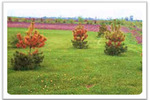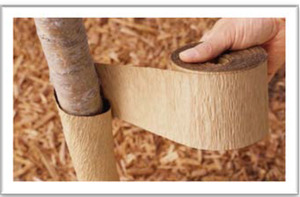Landscape
It is hard to believe that with the shorter days and the much cooler temperatures that there is anything that may pose a risk to the plant material in our landscape.
The younger deciduous trees in your yard may be at risk for something known as sun  scald. When the day time temperatures climb well above freezing combined with the fact that the sun is lower in the sky hitting the south and west sides of the trunk directly, a tree’s outer cells become active. When the temperature drops below freezing at night, these once dormant cells are damaged, potentially beyond repair. Signs of this damage can be seen in the discoloration of the young bark, cracking, or a flat spot under the bark, typically on the south or the west side of the tree.
scald. When the day time temperatures climb well above freezing combined with the fact that the sun is lower in the sky hitting the south and west sides of the trunk directly, a tree’s outer cells become active. When the temperature drops below freezing at night, these once dormant cells are damaged, potentially beyond repair. Signs of this damage can be seen in the discoloration of the young bark, cracking, or a flat spot under the bark, typically on the south or the west side of the tree.
 The end result of sun scald is the diminished transportation of nutrients to the canopy which will cause branches at the top of the tree to die off. If the damage is significant enough the tree may not recover. As a tree matures and the bark becomes thicker the risk for sun scald significantly diminishes. It can take 2 to 3 years for the bark to become thick enough to withstand the drastic temperature changes in the winter. That can vary greatly depending on what type of tree is planted in your yard. An Oak tree may need to be protected for only a couple of years while you may want to protect a Tulip Poplar, Aspen or Apple tree (for example) for five or more years. Evergreen trees typically do not have issues with sun scald due to the large amount of needles on the trees that help block the sun’s effects.
The end result of sun scald is the diminished transportation of nutrients to the canopy which will cause branches at the top of the tree to die off. If the damage is significant enough the tree may not recover. As a tree matures and the bark becomes thicker the risk for sun scald significantly diminishes. It can take 2 to 3 years for the bark to become thick enough to withstand the drastic temperature changes in the winter. That can vary greatly depending on what type of tree is planted in your yard. An Oak tree may need to be protected for only a couple of years while you may want to protect a Tulip Poplar, Aspen or Apple tree (for example) for five or more years. Evergreen trees typically do not have issues with sun scald due to the large amount of needles on the trees that help block the sun’s effects.
 There are some simple and inexpensive ways to help protect your young trees. The trunk can be wrapped with a light colored, porous tree wrap or boards can be placed against the trunk. Start wrapping the trunk at the base of the tree, working your way up, overlapping 1/3 up to the first or second branch, finishing the wrap with tape. Prior to the ground freezing in the fall, it is also helpful to give the trees a deep watering. It is important to make sure that whichever product you use, that there is sufficient air flow for the trunk. Typically you will wrap the trunk to the first or second branch.
There are some simple and inexpensive ways to help protect your young trees. The trunk can be wrapped with a light colored, porous tree wrap or boards can be placed against the trunk. Start wrapping the trunk at the base of the tree, working your way up, overlapping 1/3 up to the first or second branch, finishing the wrap with tape. Prior to the ground freezing in the fall, it is also helpful to give the trees a deep watering. It is important to make sure that whichever product you use, that there is sufficient air flow for the trunk. Typically you will wrap the trunk to the first or second branch.
Whichever way you decide to protect the tree, make sure that the material is removed in the spring, generally around Easter.
